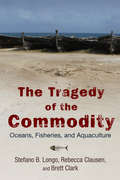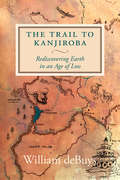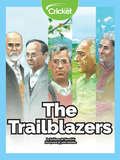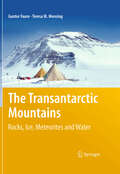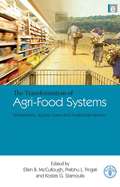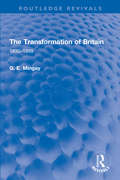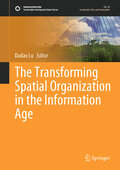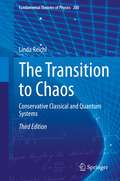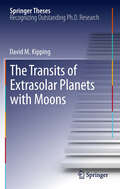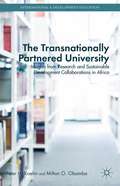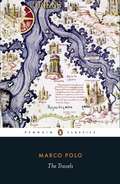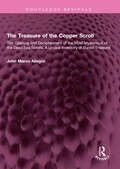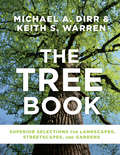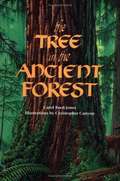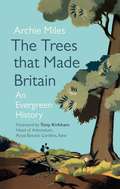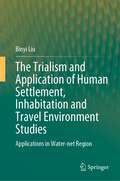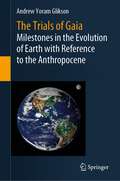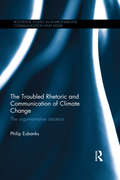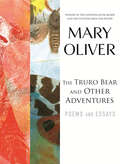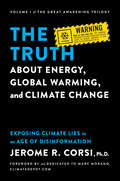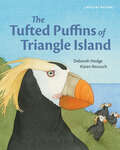- Table View
- List View
The Tragedy of the Commodity
by Stefano B. Longo Rebecca Clausen Brett ClarkAlthough humans have long depended on oceans and aquatic ecosystems for sustenance and trade, only recently has human influence on these resources dramatically increased, transforming and undermining oceanic environments throughout the world. Marine ecosystems are in a crisis that is global in scope, rapid in pace, and colossal in scale. In The Tragedy of the Commodity, sociologists Stefano B. Longo, Rebecca Clausen, and Brett Clark explore the role human influence plays in this crisis, highlighting the social and economic forces that are at the heart of this looming ecological problem. In a critique of the classic theory "the tragedy of the commons" by ecologist Garrett Hardin, the authors move beyond simplistic explanations--such as unrestrained self-interest or population growth--to argue that it is the commodification of aquatic resources that leads to the depletion of fisheries and the development of environmentally suspect means of aquaculture. To illustrate this argument, the book features two fascinating case studies--the thousand-year history of the bluefin tuna fishery in the Mediterranean and the massive Pacific salmon fishery. Longo, Clausen, and Clark describe how new fishing technologies, transformations in ships and storage capacities, and the expansion of seafood markets combined to alter radically and permanently these crucial ecosystems. In doing so, the authors underscore how the particular organization of social production contributes to ecological degradation and an increase in the pressures placed upon the ocean. The authors highlight the historical, political, economic, and cultural forces that shape how we interact with the larger biophysical world. A path-breaking analysis of overfishing, The Tragedy of the Commodity yields insight into issues such as deforestation, biodiversity loss, pollution, and climate change.
The Trail to Kanjiroba: Rediscovering Earth in an Age of Loss
by William deBuysA revitalizing new perspective on Earthcare from Pulitzer Prize finalist William deBuys.In 2016 and 2018 acclaimed author and conservationist William deBuys joined extended medical expeditions into Upper Dolpo, a remote, ethnically Tibetan region of northwestern Nepal, to provide basic medical services to the residents of the region. Having written about climate change and species extinction, deBuys went on those journeys seeking solace. He needed to find a constructive way of living with the discouraging implications of what he had learned about the diminishing chances of reversing the damage humans have done to Earth; he sought a way of holding onto hope in the face of devastating loss. As deBuys describes these journeys through one of Earth's remotest regions, his writing celebrates the land&’s staggering natural beauty, and treats his readers to deep dives into two scientific discoveries—the theories of natural selection and plate tectonics—that forever changed human understanding of our planet. Written in a vivid and nuanced style evocative of John McPhee or Peter Matthiessen, The Trail to Kanjiroba offers a surprising and revitalizing new way to think about Earthcare, one that may enable us to continue the difficult work that lies ahead.
The Trailblazers
by Kathiann M. KowalskiHere's how a few pioneers forged their own unique paths in the conservation movement.
The Transantarctic Mountains
by Gunter Faure Teresa M. MensingThis book presents a summary of the geology of the Transantarctic Mountains for Earth scientists who may want to work there or who need an overview of the geologic history of this region. In addition, the properties of the East Antarctic ice sheet and of the meteorites that accumulate on its surface are treated in separate chapters. The presentation ends with the Cenozoic glaciation of the Transantarctic Mountains including the limnology and geochemical evolution of the saline lakes in the ice-free valleys. * The subject matter in this book is presented in chronological order starting about 750 million years ago and continuing to the present time. * The chapters can be read selectively because the introduction to each chapter identifies the context that gives relevance to the subject matter to be discussed. * The text is richly illustrated with 330 original line drawings as well as with 182 color maps and photographs. * The book contains indexes of both subject matter and of authors' names that allow it to be used as an encyclopedia of the Transantarctic Mountains and of the East Antarctic ice sheet. * Most of the chapters are supplemented by Appendices containing data tables, additional explanations of certain phenomena (e.g., the formation and seasonal destruction of stratospheric ozone), and illustrative calculations (e.g., 38Cl dates of meteorites). * The authors have spent a combined total of fourteen field seasons between 1964 and 1995 doing geological research in the Transantarctic Mountains with logistical support by the US Antarctic Program. * Although Antarctica is remote and inaccessible, tens of thousands of scientists of many nationalities and their assistants have worked there and even larger numbers of investigators will work there in the future.
The Transformation of Agri-Food Systems: Globalization, Supply Chains and Smallholder Farmers
by Ellen B. McCullough Prabhu L. Pingali Kostas G. Stamoulis'There should be a good market for this book. The topic is very timely and a major theme of the new World Development Report 2008. The editors and contributors are world class.' Derek Byerlee, World Bank 'This is a topic of wide interest and high policy importance. The depth of coverage and excellent synthesis should ensure that the book will have a substantial market in high-level undergraduate and graduate courses in agricultural development. It will have a solid readership among development economists and policy makers as well.' Mark Rosegrant, International Food Policy Research Institute The driving forces of income growth, demographic shifts, globalization and technical change have led to a reorganization of food systems from farm to plate. The characteristics of supply chains - particularly the role of supermarkets - linking farmers have changed, from consumption and retail to wholesale, processing, procurement and production. This has had a dramatic effect on smallholder farmers, particularly in developing countries. This book presents a comprehensive framework for assessing the impacts of changing agri-food systems on smallholder farmers, recognizing the importance of heterogeneity between developing countries as well as within them. The book includes a number of case studies from Asia, Africa, Latin America and Eastern Europe, which are used to illustrate differences in food systems' characteristics and trends. The country case studies explore impacts on the small farm sector across different countries, local contexts and farm types. Published with FAO
The Transformation of Britain: 1830–1939 (Routledge Revivals)
by G. E. MingayFirst published in 1986, The Transformation of Britain, 1830–1939 delves into the significant changes that occurred across the landscape and society of Britain during this prominent age of reform and innovation. The book traces the rapid increase in the pace and scale of change across Britain, and explores the key developments that occurred. It examines the changes in population as more people moved towards towns and cities; the growth in industry and trade and the resultant demand for methods of communication and transport; and the technological advancements in all areas of life. It highlights the impact that these changes left on the landscape of Britain, such as through the building of roads and railways, as well as on Britain’s social structure. It also considers the extent to which this crucial period shaped the successes and problems of modern Britain. The Transformation of Britain, 1830–1939 will appeal to those with an interest in the social and industrial history of Britain.
The Transforming Spatial Organization in the Information Age (Sustainable Development Goals Series)
by Dadao LuThis book provides a critical account, a state-of-the-art review, as well as novel research methods of information technology development and the corresponding changes of socio-economic spatial organization in China.With the rapid development of the Internet over the past three decades, the development of information technology and its impact on social economy have become an important frontier issue of human and economic geography. Actually, the influence of information technology is complex and dynamic, involving almost all aspects of socio-economic activities and our daily life. It is also influencing the methods and disciplines that we use to understand it. In general, industrial development and regional management and innovation are the core contents of socio-economic spatial organization. Therefore, changes in industrial clusters, transportation logistics, regional development and innovation, urban planning and management, and rural development under the background of the information age were analysed to understand the relationship among information revolution, socio-economic spatial organization, and human and economic geography.Primarily intended for scholars and graduate students across a range of disciplines, such as geography, urban-rural planning, information science, urban science, economics and sociology, and people engaged in regional planning, urban management and information management, this book proves to be an innovative and up-to-date resource.
The Transition to Chaos: Conservative Classical and Quantum Systems (Fundamental Theories of Physics #200)
by Linda ReichlBased on courses given at the universities of Texas and California, this book treats an active field of research that touches upon the foundations of physics and chemistry. It presents, in as simple a manner as possible, the basic mechanisms that determine the dynamical evolution of both classical and quantum systems in sufficient generality to include quantum phenomena. The book begins with a discussion of Noether's theorem, integrability, KAM theory, and a definition of chaotic behavior; continues with a detailed discussion of area-preserving maps, integrable quantum systems, spectral properties, path integrals, and periodically driven systems; and concludes by showing how to apply the ideas to stochastic systems. The presentation is complete and self-contained; appendices provide much of the needed mathematical background, and there are extensive references to the current literature; while problems at the ends of chapters help students clarify their understanding. This new edition has an updated presentation throughout, and a new chapter on open quantum systems.
The Transits of Extrasolar Planets with Moons
by David M. KippingCan we detect the moons of extrasolar planets? For two decades, astronomers have made enormous progress in the detection and characterisation of exoplanetary systems but the identification of an "exomoon" is notably absent. In this thesis, David Kipping shows how transiting planets may be used to infer the presence of exomoons through deviations in the time and duration of the planetary eclipses. A detailed account of the transit model, potential distortions, and timing techniques is covered before the analytic forms for the timing variations are derived. It is shown that habitable-zone exomoons above 0.2 Earth-masses are detectable with the Kepler space telescope using these new timing techniques.
The Transnationally Partnered University
by Peter H. Koehn Milton O. ObambaAnalyzing the growing importance of the transnational higher education landscape and the role of African universities, Koehn and Obamba show how transnational partnerships among universities can inform policy, strengthen synergies between knowledge producers and knowledge users, and advance sustainable-development practice.
The Travels
by Marco Polo Nigel CliffA sparkling new translation of one of the greatest travel books ever written- Marco Polo's seminal account of his journeys in the east. Marco Polo was the most famous traveller of his time. His voyages began in 1271 with a visit to China, after which he served the Kublai Khan on numerous diplomatic missions. On his return to the West he was made a prisoner of war and met Rustichello of Pisa, with whom he collaborated on this book. His account of his travels offers a fascinating glimpse of what he encountered abroad- unfamiliar religions, customs and societies; the spices and silks of the East; the precious gems, exotic vegetation and wild beasts of faraway lands. Evoking a remote and long-vanished world with colour and immediacy, Marco's book revolutionized western ideas about the then unknown East and is still one of the greatest travel accounts of all time. For this edition - the first completely new English translation of the Travels in over fifty years - Nigel Cliff has gone back to the original manuscript sources to produce a fresh, authoritative new version. The volume also contains invaluable editorial materials, including an introduction describing the world as it stood on the eve of Polo's departure, and examining the fantastical notions the West had developed of the East.
The Treasure of the Copper Scroll: The Opening and Decipherment of the Most Mysterious of the Dead Sea Scrolls, A Unique Inventory of Buried Treasure (Routledge Revivals)
by John Marco AllegroFirst published in 1960, The Treasure of the Copper Scroll is the companion volume to John Marco Allegro’s People of the Dead Sea Scrolls and tells the story of this unusual, buried treasure. Allegro here reveals much hitherto unknown information – the location of many of the cities of the Old Testament, events of the second Jewish Revolt, and the relation between the Essene community at Qumran and the New Testament interest in healing. With facsimiles of the scroll, translations of its texts, and a thorough discussion of its significance, with maps indicating many of the probable present-day hiding places, the book is a truly fascinating report on this unusual document and a first long step toward the unravelling of its secrets.
The Tree Book: Superior Selections for Landscapes, Streetscapes, and Gardens
by Michael A. Dirr Keith S. Warren“A boon to all those who plant, care for, and love trees.”—Nina Bassuk, author of Trees in the Urban Landscape The Tree Book is the go-to reference to more than 2,400 species and cultivars, from two of the biggest names in horticulture—Michael A. Dirr and Keith S. Warren. The featured trees include those widely available in the nursery trade, some new and promising choices, and a selection of overlooked options that deserve renewed interest. Each tree profile includes the common and botanical names along with details on foliage; flowers, seeds, fruits, and cones; native range; adaptability; and popular uses in landscapes. The Tree Book is a must-have resource for landscapes architects, city foresters, horticulturists, and enthusiastic home gardeners.
The Tree In The Ancient Forest
by Carol Reed-Jones Christopher CanyonAncient trees embrace a wonderful world of creatures, each playing their special role. From lowly fungi to majestic owls, the book connects the web of nature and aptly portrays the amazing ways in which the inhabitants of the forest depend upon one another for survival. Stunning illustrations by the renowned illustrator, Christopher Canyon, manage to be both magical and true. As AAAS Science Books & Films says, "The science is accurate and the book painlessly teaches important ecological lessons. "
The Tree: John Fowles
by John FowlesThe classic meditation on creativity and the natural world“For years I have carried this book. . . with me on travels to reread, ponder, envy. In prose of classic gravity, precision, and delicacy, Fowles addresses matters of final importance.” —W. S. Merwin, Los Angeles Times Book Review“The Tree is the fullest and finest exploration I’ve ever read of how the useless delights to be discovered in nature can ripen into the practice of art.” —Lewis Hyde, author of The GiftFirst published a generation ago, The Tree is renowned English novelist John Fowles's provocative meditation on the connection between the natural world and human creativity, and a powerful argument against taming the wild. In it, Fowles recounts his own childhood in England and describes how he rebelled against his Edwardian father’s obsession with the “quantifiable yield” of well-pruned fruit trees and came to prize instead the messy, purposeless beauty of nature left to its wildest.The Tree is an inspiring, even life-changing book, one that reaffirms our connection to nature and reminds us of the pleasure of getting lost, the merits of having no plan, and the wisdom of following one’s nose wherever it may lead—in life as much as in art.This special 30th anniversary edition includes an introduction by Barry Lopez.
The Treehouse Book
by Candida CollinsThe Treehouse Book is a global round-up of the best in modern treehouse living. Tree houses have come of age. The image of a few planks nailed into the branches of a tree has changed into a new generation of specially designed and built structures, suitable as a playhouse, a study, or even a guestroom. Totally inhabitable and filled with designer furniture, plumbing, and electronic wizardry, the twenty tree houses featured in this book are to be admired, dreamed about, and even built. Featuring spectacular photography of exteriors set up among the trees, and interior shots that offer design ideas for living the &“high&” life, The Treehouse Book offers a fairy tale castle, a thatched cottage, a complete hotel, and much more. Each project was designed using computer technology and built using sustainable materials to create structures that only seem like fantasy. Each is cleverly fitted to the chosen trees, avoiding long-term damage to these remarkable structures. With a section on plans and building techniques to help the competent reader design and build a fabulous tree house for him or herself, The Treehouse Book will inspire everyone to dream about what life would be like leaving all cares and worries behind and below. From basic cabins suspended in the trees, to the unbelievable "High-Tech Hideaway," The Treehouse Book may inspire us to commission the retreat of our dreams ... or to get out the hammer and nails!
The Trees that Made Britain: Revised Edition
by Archie MilesAs the oldest living inhabitants on the planet, trees have played a major part in the way we live today, providing both the daily oxygen we breathe and the foundation of our nations heritage. Every native tree in Britain, whether its part of a grand avenue, a thriving hedgerow, an ancient wood or a colourful orchard, tells a different story. The Trees That Made Britain takes us on a journey of discovery to every corner of the nation. Through detailed portraits of individual tree species, author and photographer Archie Miles reveals the stories of the trees that have influenced the culture, myths and fabric of the nation. The book is full of surprising facts on how trees have been used by man over the centuries, from the oak used in the building of HMS Victory to ancient longbows made from yew, as well as practical advice on visiting some of Britains finest living examples. The combination of rich historical material and lyrical descriptions captures the essence of our native tree species.
The Trialism and Application of Human Settlement, Inhabitation and Travel Environment Studies: Applications in Water-net Region
by Binyi LiuThis book studies human settlements in China in terms of Human Settlements Trialism in 5 typical human settlement types: river valleys, water networks, hills, plains, and arid areas. Focusing on 3 elements of Trialism—(1) natural and constructed environments, resources, and visual landscapes in human settlements background; (2) survival strategies, customs, culture, and values in human settlements activity; and (3) the layout of time and space as well as the planning and design of the urban, the country, and the wilderness in human settlements construction—the book analyzes the evolution of human settlements and predicts future trends. Presenting academic researchers and graduate students in various fields with insights from landscape architecture, urban planning, architecture, geography, forestry, art, and psychology, the study discusses the principles of interactive physiological thinking and systematically theoretical philosophy related to professional physiology, planning and design principles, and traditional and modern methods and technologies in urban and rural construction. The innovative multi-discipline study promotes the planning and design of 5 types of human settlement, which is helpful to the judgment of value, activity rule, and living style of human settlements, and also discusses the development of human settlements in the new millennium.
The Trials of Gaia: Milestones in the Evolution of Earth with Reference to the Anthropocene
by Andrew Yoram GliksonThis books presents a documentation and resulting perspectives regarding James Lovelock's multidisciplinary evolution theory. It looks at past and current climate changes and their consequences, including detailed accounts of the global warming. The connection between climate trajectories and extreme weather events, including tropical and arctic fronts, cyclones, fire storms, tropical storms, acidification, tsunami, floods, sea level rise, are referred to in connection with recent developments. The book updates earlier accounts regarding extreme weather events and mass extinctions.The book “The Trials of Gaia” is published in honour of the late Professor James Lovelock (26 July 1919 – 26 July 2022), the father of the Gaia theory.
The Triumphant Tale of the House Sparrow
by Jan Thornhill“The content encourages us to reflect upon and evaluate the relationship between human beings and animals. This book leaves us with admiration for this feisty bird and hope for our world.” — Friends Journal Behold the most despised bird in human history!So begins Jan Thornhill’s riveting, beautifully illustrated story of the House Sparrow. She traces the history of this perky little bird, one of the most adaptable creatures on Earth, from its beginnings in the Middle East to its spread with the growth of agriculture into India, North Africa and Europe. Everywhere the House Sparrow went, it competed with humans for grain, becoming such a pest that in some places “sparrow catcher” became an actual job and bounties were paid to those who got rid of it.But not everyone hated the House Sparrow, and in 1852, fifty pairs were released in New York City. In no time at all, the bird had spread from coast to coast. Then suddenly, at the turn of the century, as cars took over from horses and there was less grain to be found, its numbers began to decline. As our homes, gardens, cities and farmland have changed, providing fewer nesting and feeding opportunities, the House Sparrow’s numbers have begun to decline again — though in England and Holland this decline appears to be slowing. Perhaps this clever little bird is simply adapting once more.This fascinating book includes the life history of the House Sparrow and descriptions of how the Ancient Egyptians fed it to the animals they later mummified, how it traveled to Great Britain as a stowaway on ships carrying Roman soldiers, and how its cousin, the Eurasian Tree Sparrow, was almost eradicated in China when Mao declared war on it. A wealth of back matter material is also supplied.Key Text Featuresmapglossaryreferencesresourcesfurther informationCorrelates to the Common Core State Standards in English Language Arts:CCSS.ELA-LITERACY.RI.3.3Describe the relationship between a series of historical events, scientific ideas or concepts, or steps in technical procedures in a text, using language that pertains to time, sequence, and cause/effect.CCSS.ELA-LITERACY.RI.3.7Use information gained from illustrations (e.g., maps, photographs) and the words in a text to demonstrate understanding of the text (e.g., where, when, why, and how key events occur).CCSS.ELA-LITERACY.RI.4.3Explain events, procedures, ideas, or concepts in a historical, scientific, or technical text, including what happened and why, based on specific information in the text.CCSS.ELA-LITERACY.RI.5.3Explain the relationships or interactions between two or more individuals, events, ideas, or concepts in a historical, scientific, or technical text based on specific information in the text.CCSS.ELA-LITERACY.RI.6.2Determine a central idea of a text and how it is conveyed through particular details; provide a summary of the text distinct from personal opinions or judgments.
The Troubled Rhetoric and Communication of Climate Change: The argumentative situation (Routledge Studies in Environmental Communication and Media)
by Philip EubanksDespite an overwhelming scientific consensus, climate change remains one of the most controversial issues of our time. Focusing on the rhetoric that surrounds the issue of climate change, this groundbreaking book analyses why the debate continues to rage and examines how we should argue when winning the argument really matters. Going beyond routine condemnations of the wildest statements made by religious fundamentalists or spokespeople for fossil fuel interests, the book explains the mutually exacerbating problems that permit many of us greet catastrophic predictions with an equivocal shrug. It argues that the argumentative situation around climate change makes a certain kind of skepticism – "fair-minded skepticism" – not only possible but likely. The book also strikes a hopeful note, reminding us that people do change their minds in response to effective argumentation that appeals to deeply shared values. Offering new insight into an ongoing academic discussion about the nature of argument and how it can be undertaken more effectively and ethically, as well as a new perspective on the rhetoric of science and technology, this book will be a valuable resource to students and scholars of climate change, environmental humanities, rhetoric, environmental communication, sociology and science and technology studies.
The Troubled Roar Of The Waters: Vermont In Flood And Recovery, 1927-1931
by Deborah Pickman Clifford Nicholas R. CliffordIn their new book, Deborah Pickman Clifford and Nicholas R. Clifford revisit the devastating flood that wreaked unprecedented destruction on New England in November 1927. Vermont sustained the greatest damage by far, with eighty-four deaths (or three-quarters of the total casualties) and property losses totaling thirty to forty million in 1927 dollars (more than eighty-six dollars for every man, woman, and child then in the state). These losses were proportionally far higher than the corresponding ones suffered in the regions ravaged by the huge Mississippi floods earlier that year. In these pre-FEMA years and in true Green Mountain State style, Vermonters by and large had to confront the emergency on their own, and this at a time when the boom of the mid and late 1920s had largely bypassed Vermont, a rural state with little industry and a stagnant population. Contrary to popular belief, however,Vermont did accept federal, Red Cross, and other outside assistance. "The Troubled Roar of the Waters" is the story of the flood, the formation and work of emergency relief committees, the efforts to rebuild in a harsh climate, and the ways in which the disaster fundamentally affected the state's political and social development. Though the 1920s traditionally have been represented primarily as a prelude to the Depression and the New Deal, new scholarship sees the nation entering a period of rapid and unnerving change in these years. Cities and suburbs mushroomed, the automobile revolutionized society, new and larger forms of business and industry flourished, and tensions mounted between new immigrants and the "old stock. " The Cliffords build on this, using public and private archival collections to inform their riveting story, fleshing out the historical record and adding key perspectives to this broader emerging debate over how the decade is viewed. For specialists and general readers alike, the authors place the story of the 1927 flood within the larger context of early twentieth-century American history, establishing the event and its aftermath as emblematic of the age.
The Truro Bear and Other Adventures: Poems and Essays
by Mary OliverThe Truro Bear and Other Adventures, a companion volume to Owls and Other Fantasies and Blue Iris, brings together ten new poems, thirty-five of Oliver's classic poems, and two essays all about mammals, insects, and reptiles. The award-winning poet considers beasts of all kinds: bears, snakes, spiders, porcupines, humpback whales, hermit crabs, and, of course, her beloved but disobedient little dog, Percy.
The Truth about Energy, Global Warming, and Climate Change: Exposing Climate Lies in an Age of Disinformation
by Jerome R. CorsiThis book exposes the truth that the climate change hoax is a political movement aimed at eliminating capitalism by spreading alarming disinformation that in order to &“save the Earth&” from global warming, we must reduce carbon dioxide emissions by switching from hydrocarbon fuels to renewable energies.The Truth about Energy, Global Warming, and Climate Change: Exposing Climate Lies in an Age of Disinformation reveals a science-based understanding of Earth&’s climate and temperature that Green New Deal proponents are trying to hide. In the pages of this book, you will see scientifically documented evidence for many facts that the radical left denies. Want to know the truth about how energy, temperature, and climate work? Read The Truth about Energy, Global Warming, and Climate Change—but prepare to be shocked. Jerome R. Corsi has conducted a tour-de-force examination of peer-reviewed climate science that exposes the neo-Marxists behind today&’s anti-capitalist global warming hoax.
The Tufted Puffins of Triangle Island (Wild by Nature)
by Deborah HodgeThousands of beautiful tufted puffins arrive each spring to lay their eggs on the remote and rugged Triangle Island, a rare and protected habitat. In this lushly illustrated first book in the Wild by Nature series, young readers will meet a pair of puffins preparing a burrow on the steep cliffside of Triangle Island, off the northwestern tip of Vancouver Island. In this remarkable place, they will lay a single egg and raise their baby. Here, the birds are protected, and there is ample space to nest, and fish to eat. At summer’s end, the puffins, young and old, fly away to live at sea. The young puffins will live on the ocean until they are mature enough to return to their birthplace and lay their own eggs. If Triangle Island remains undisturbed, and the ocean stays cool, clean and full of fish, the new baby puffins will continue to thrive and grow. Includes an author’s note about Triangle Island and other sea birds that nest there. WILD BY NATURE A series for young readers that explores the unique links between ecologically sensitive species and their habitats, and encourages the preservation of the world’s wild places. Key Text Features illustrations author’s note further information further reading facts Correlates to the Common Core State Standards in English Language Arts: CCSS.ELA-LITERACY.RI.1.3 Describe the connection between two individuals, events, ideas, or pieces of information in a text. CCSS.ELA-LITERACY.RI.2.6 Identify the main purpose of a text, including what the author wants to answer, explain, or describe. CCSS.ELA-LITERACY.RI.2.7 Explain how specific images (e.g., a diagram showing how a machine works) contribute to and clarify a text.
